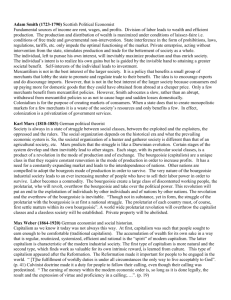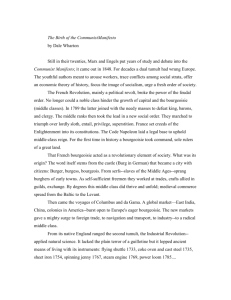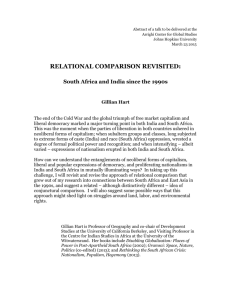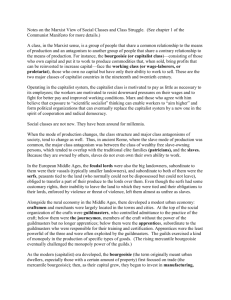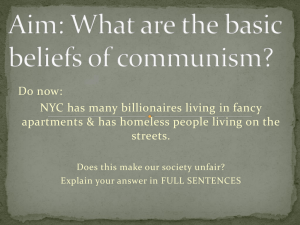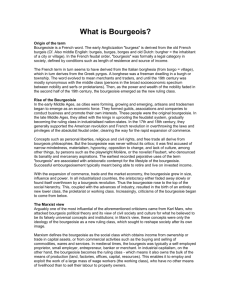4 Capitalism and Bourgeois Society
advertisement
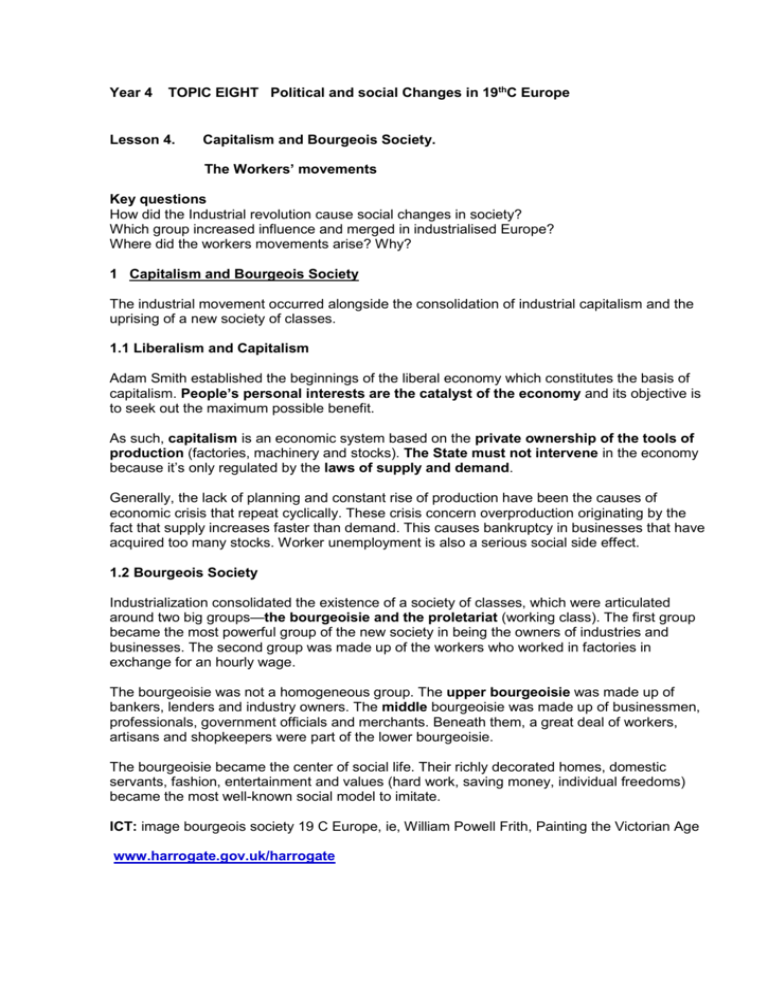
Year 4 TOPIC EIGHT Political and social Changes in 19thC Europe Lesson 4. Capitalism and Bourgeois Society. The Workers’ movements Key questions How did the Industrial revolution cause social changes in society? Which group increased influence and merged in industrialised Europe? Where did the workers movements arise? Why? 1 Capitalism and Bourgeois Society The industrial movement occurred alongside the consolidation of industrial capitalism and the uprising of a new society of classes. 1.1 Liberalism and Capitalism Adam Smith established the beginnings of the liberal economy which constitutes the basis of capitalism. People’s personal interests are the catalyst of the economy and its objective is to seek out the maximum possible benefit. As such, capitalism is an economic system based on the private ownership of the tools of production (factories, machinery and stocks). The State must not intervene in the economy because it’s only regulated by the laws of supply and demand. Generally, the lack of planning and constant rise of production have been the causes of economic crisis that repeat cyclically. These crisis concern overproduction originating by the fact that supply increases faster than demand. This causes bankruptcy in businesses that have acquired too many stocks. Worker unemployment is also a serious social side effect. 1.2 Bourgeois Society Industrialization consolidated the existence of a society of classes, which were articulated around two big groups—the bourgeoisie and the proletariat (working class). The first group became the most powerful group of the new society in being the owners of industries and businesses. The second group was made up of the workers who worked in factories in exchange for an hourly wage. The bourgeoisie was not a homogeneous group. The upper bourgeoisie was made up of bankers, lenders and industry owners. The middle bourgeoisie was made up of businessmen, professionals, government officials and merchants. Beneath them, a great deal of workers, artisans and shopkeepers were part of the lower bourgeoisie. The bourgeoisie became the center of social life. Their richly decorated homes, domestic servants, fashion, entertainment and values (hard work, saving money, individual freedoms) became the most well-known social model to imitate. ICT: image bourgeois society 19 C Europe, ie, William Powell Frith, Painting the Victorian Age www.harrogate.gov.uk/harrogate 2 The Workers´ Response http://www.spartacus.schoolnet.co.uk As the number of factory workers increased, a new social class appeared: the urban, industrial proletariat. These poorly qualified workers developed a rhythmic, machine-like work technique as they were subject to the machines and discipline of the factories. 2.1 The Workers Workers´ day-to-day working conditions during the first decades of industrialization were precarious. The work day was between 12 and 14 hours long and the wages weren’t enough to support a family. Subsequently women and children also worked and for a wage lower than that of men. Furthermore, workshops lacked in terms of hygienic conditions causing illnesses. There was no sort of legislation that regulated work conditions. Wages were arbitrarily established by the business owner. The majority of workers came from rural areas and had immigrated to cities in search of work opportunities. They set up living quarters in neighborhoods that didn’t provide adequate sanitary or hygienic conditions. Streets were neither paved nor had appropriate sewer systems and lots of people lived in very tight quarters. Typhoid fever and cholera were very common and spread throughout communities very quickly. 2.2 The First Workers´ Associations Workers´ first response was to oppose the use of machines as they were responsible for worker unemployment and low wages. The Luddites (Ned Ludd) destroyed machines and burned down buildings This form of resistance was visible throughout Europe during the first decades of the 19th century. Similarly, important sectors of workers began to realize that they were part of a different social class with shared problems and common goals. To defend their interests, they created workers´ organizations and at the end of the 18th century the Societies of Mutual Aid in Great Britain was founded. These societies grouped together workers with better wages given that their members satisfied certain quotas. Their objective was to act as resistance forces to help out their members economically during times of illness or unemployment. 2. 3 Unionism Governments reacted negatively to the formation of worker unions, the majority of which were declared illegal. In 1834 the Great Trade Union was established as a syndicate made up of persons of various trades. In Spain, the first union organization was the Association de Tejedores/ Weavers de Barcelona in 1840. The goal of the unions was to improve the work conditions for the workers. Their first demands were: defending their right of association, the reduction of work hours, better wages and the regulation of child labor. 3 Marxism, Anarchism and Internationalism With the consolidation of the industrial society, various thinkers denounced poor worker conditions and the social inequalities of capitalism. These intellectuals criticized the concentration of wealth in the hands of just a few and proposed a mew model of social organization based on collective ownership. 3.1 Marxism In the middle of the 19th century Karl Marx and Friedrich Engels rejected the exploitation of the working class by the bourgeoisie and defended the necessity of a workers´ revolution to destroy capitalism. The proletariat would assume political power and create a workers´ State that socialized property that would remain in the hands of the State. The end of private ownership would lead to the disappearance of social classes as well as the State in order to reach the ideal socialist communism—a society without a State and without classes. Since the last part of the 19th century, Marxists proposed the creation of socialist workers’ parties that expanded throughout all of Europe. Their goal was to achieve a proletarian revolution but also to defend political participation and the ability to run in elections. In this way, socialist members of Parliament imposed legislation that was favorable for workers (universal suffrage even for women, progressive rent tax, 8-hour work day…). 3. 2 Anarchism The idea of anarchism brought together a group of thinkers (Proudhon, Bakunin, Kropotkin) that had three basic principles in common: advancement of individual liberty and social solidarity; criticism of private ownership and the defense of collective ownership; and the rejection of authority, principally authority of the State. They defended revolutionary peasant and proletarian action to destroy the State in order to create a new egalitarian society. Anarchists opposed all political participation in addition to the organization of workers into political parties. Some defended violent actions against the pillars of capitalism (bourgeoisie, the State and the Church). Others supported the creation of revolutionary syndicates in order to improve workers´ conditions and to catapult the social revolution. Definition Anarchism(anar-kisim)(from Greek ἀν (without) + ἄρχειν (to rule) + ισμός (from stem -ιζειν), "without archons," "without rulers") is a political philosophy encompassing theories and attitudes which reject compulsory government (the state) and support its elimination,[often due to a wider rejection of involuntary or permanent authority Anarchism is defined by The Concise Oxford Dictionary of Politics as "the view that society can and should be organized without a coercive state 3.3 Internationalism Marxists and anarchists defended the necessity to unite forces among social classes worldwide to fight against capitalism (Proletarian Internationalism). The International Workingmen's Association (IWA), also known as the First International, was founded in by Marx´ initiative in 1864 in London. Marxists, anarchists and syndicalists were all in favor of this association. The noteworthy ideological differences between Marxists and anarchists made the association useless and it disappeared around 1876. As the ideas of Marx and Engels took on flesh, particularly in central Europe, socialists sought to unite in an international organization. In 1889, on the centennial of the French Revolution of 1789, the Second International (International II) was founded,. This association was an exclusively socialist organization whose objective was to coordinate programs and interventions. I t was termed the "Socialist International" and Engels was elected honorary president at the third congress in 1893. International II created symbols relating to identity of the workers´ movement: the International hymn and the May 1st holiday commemorating the Day of the Worker. Vocabulary


